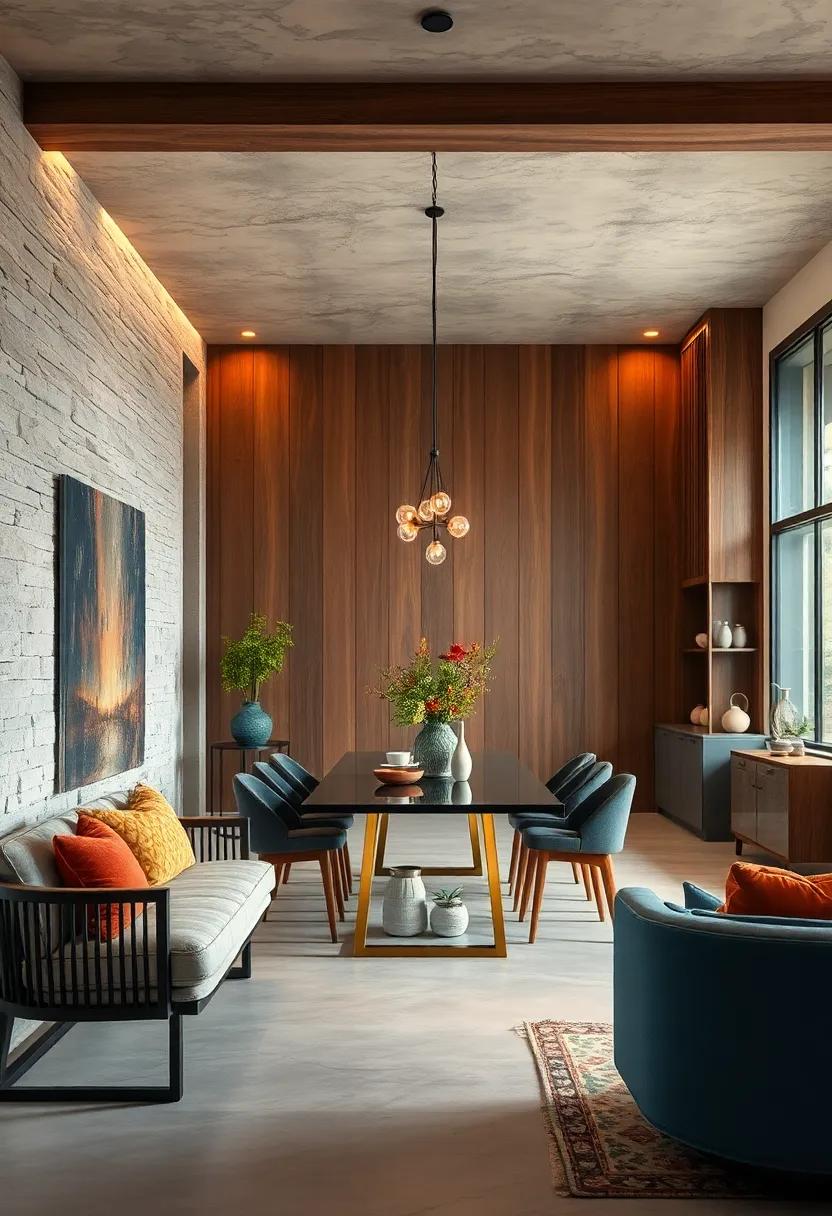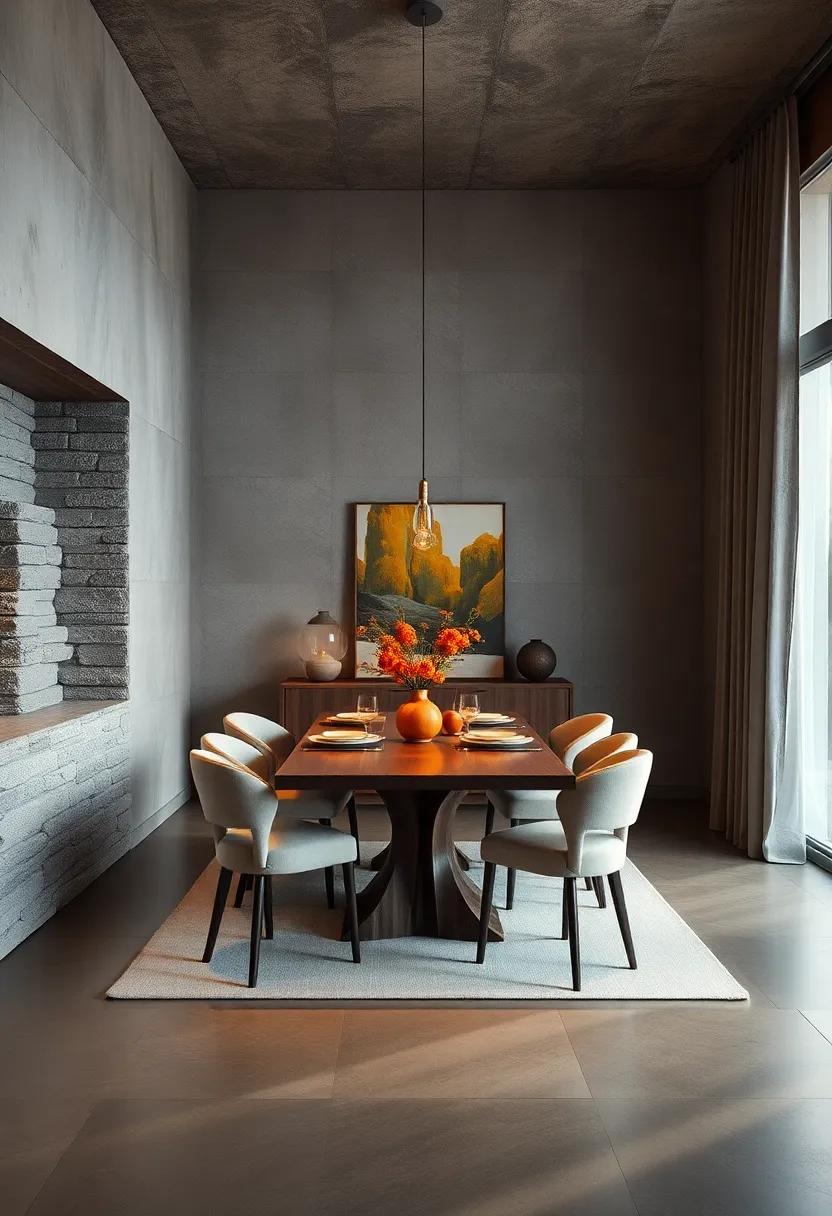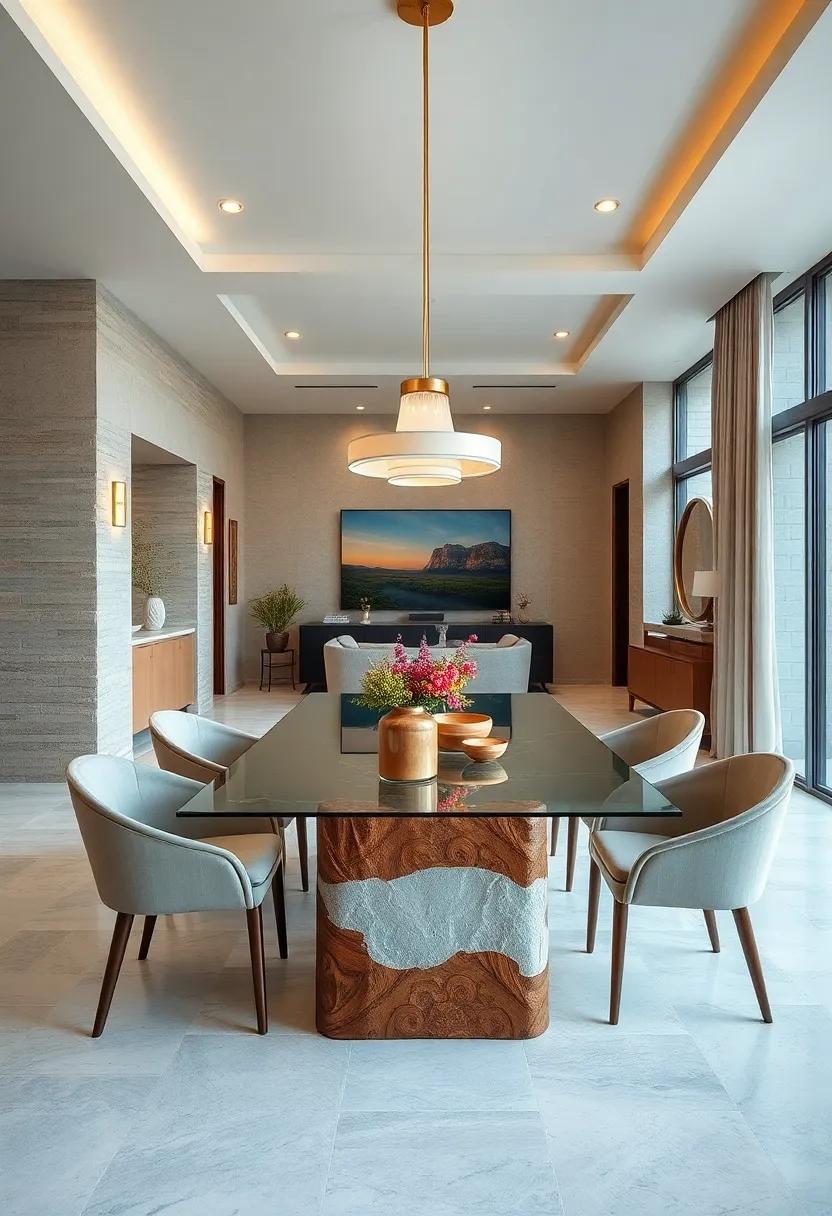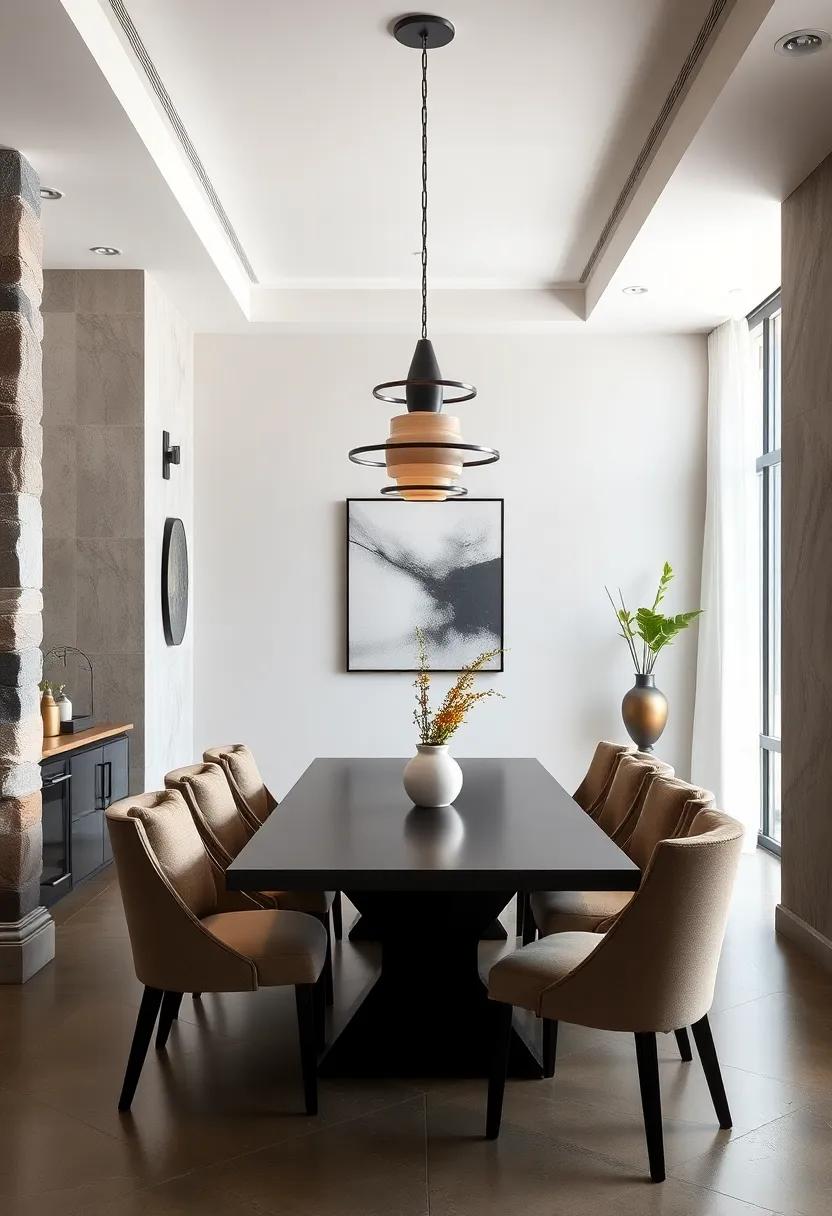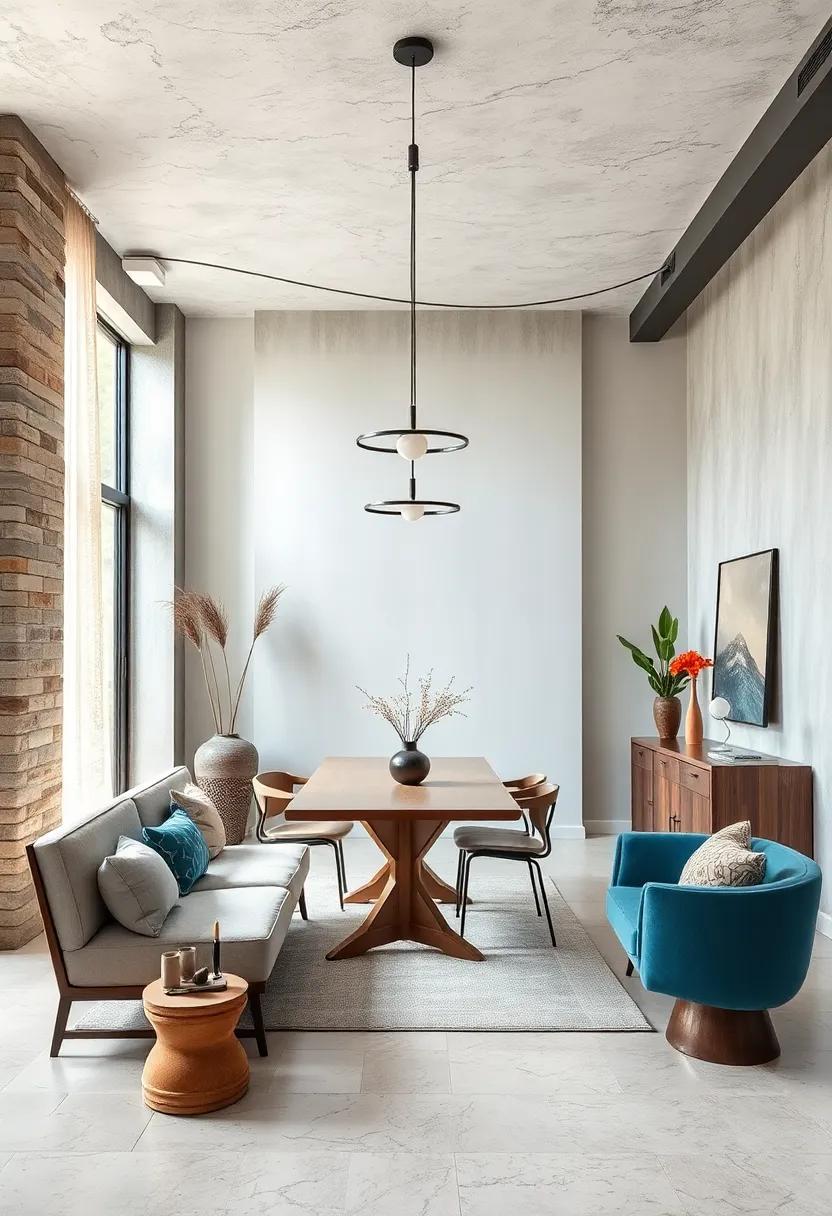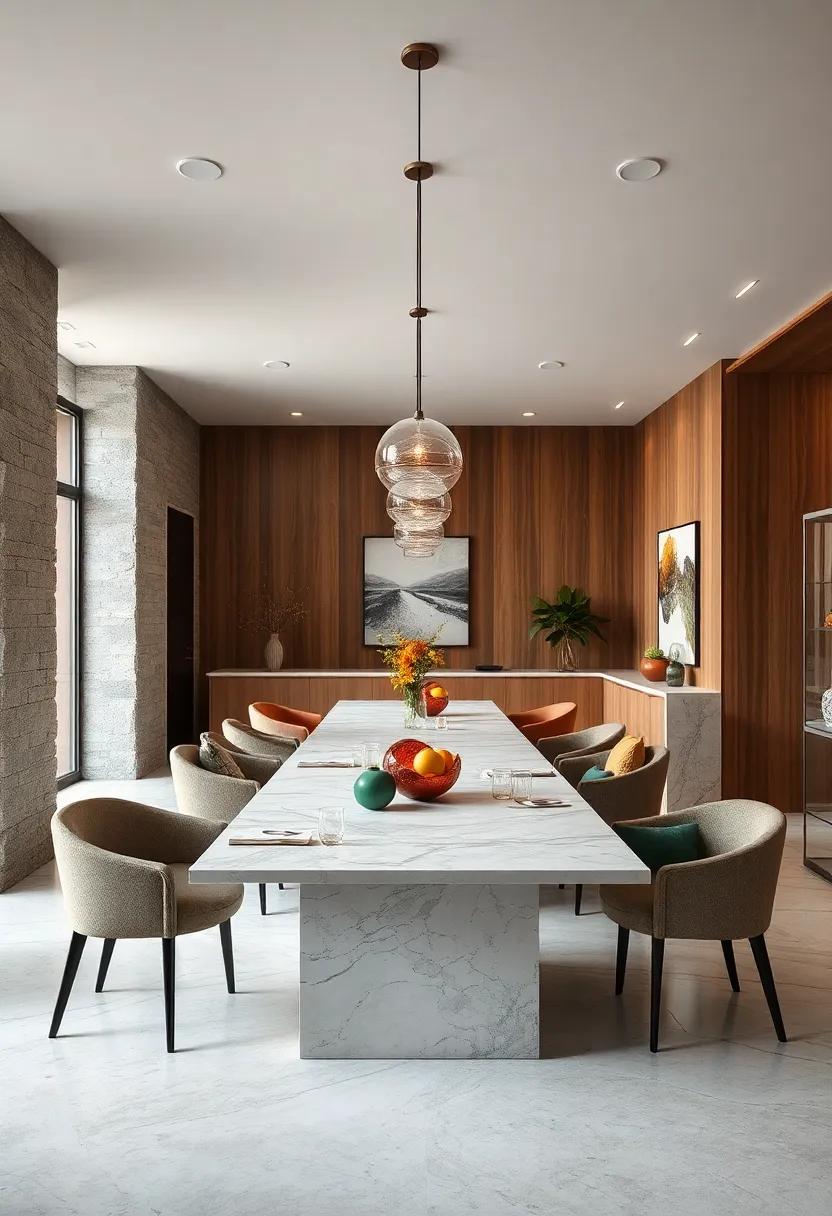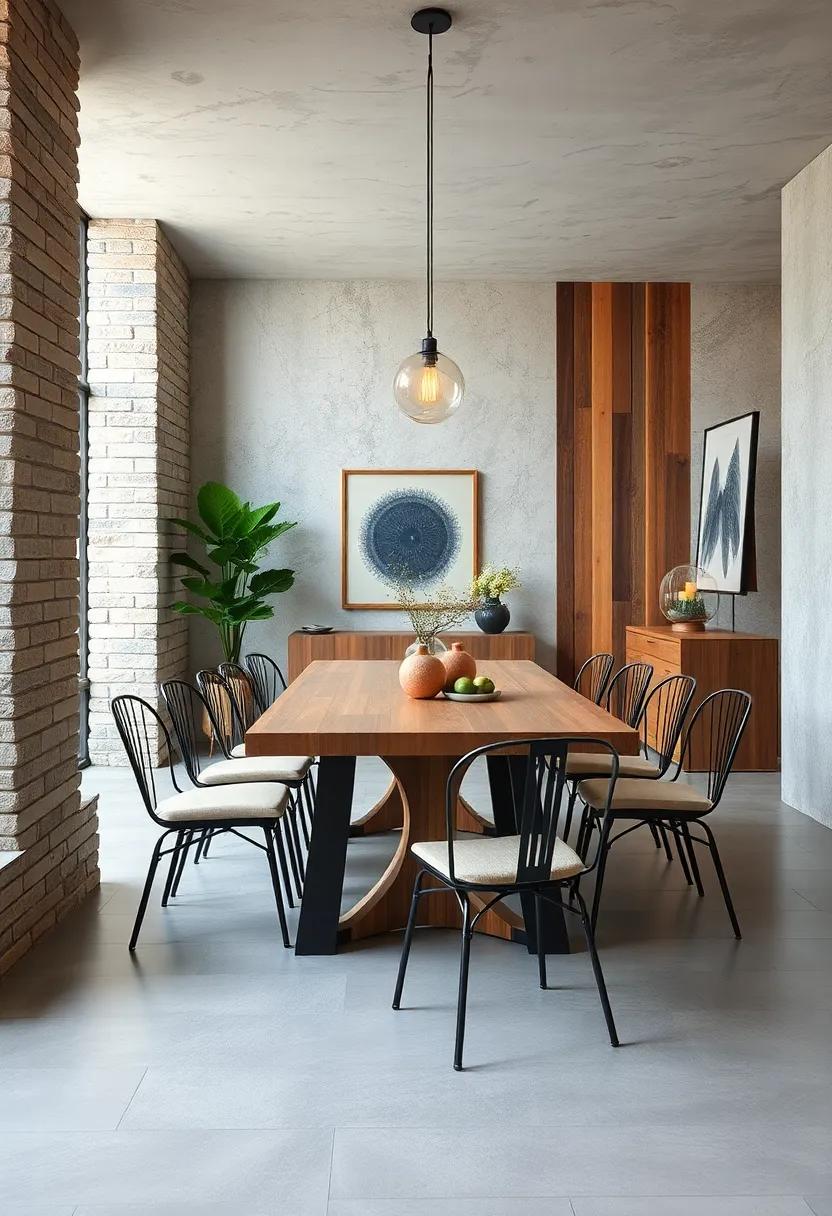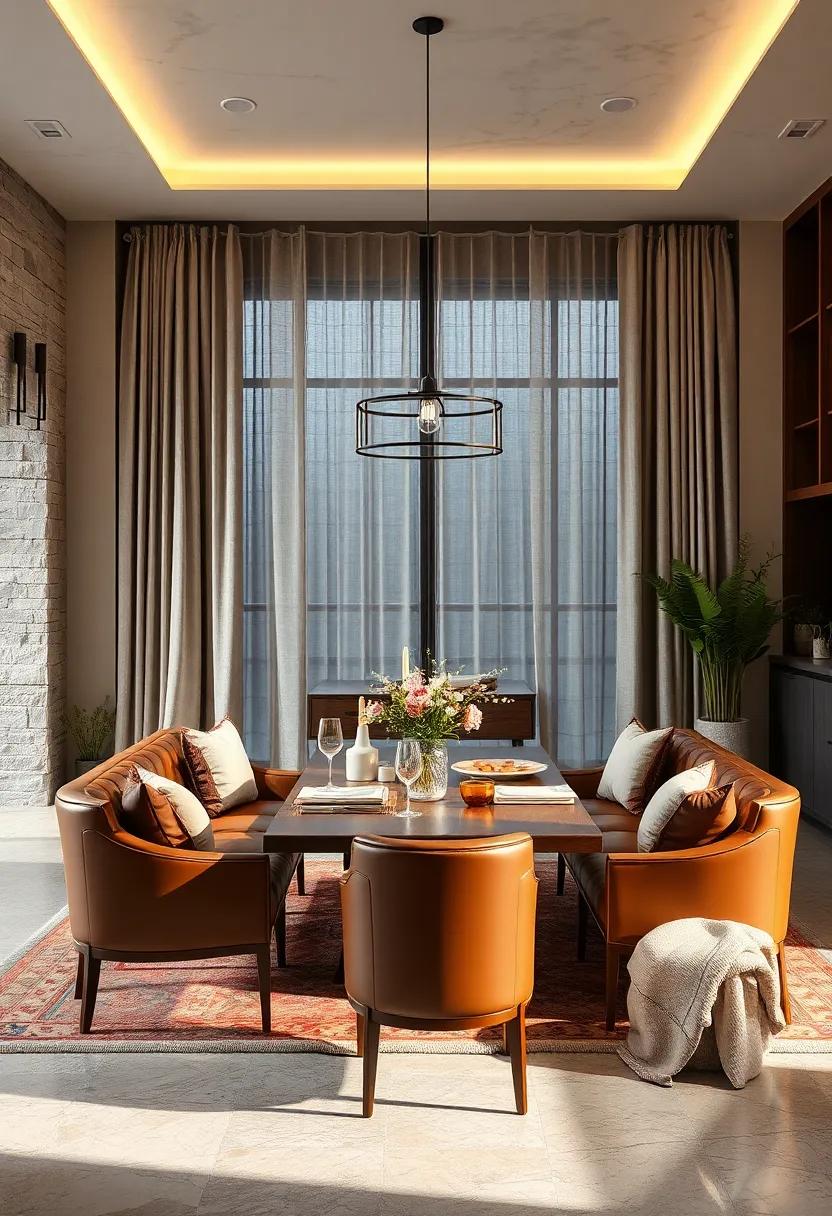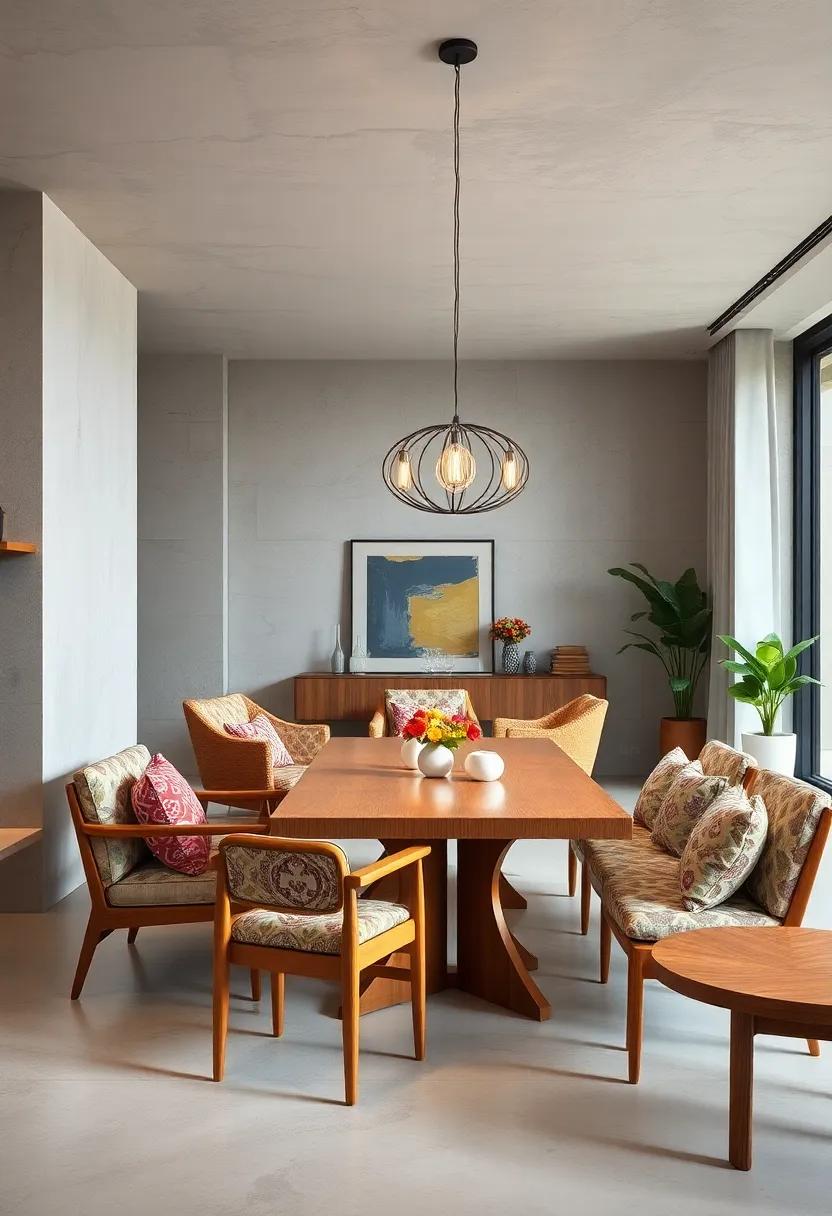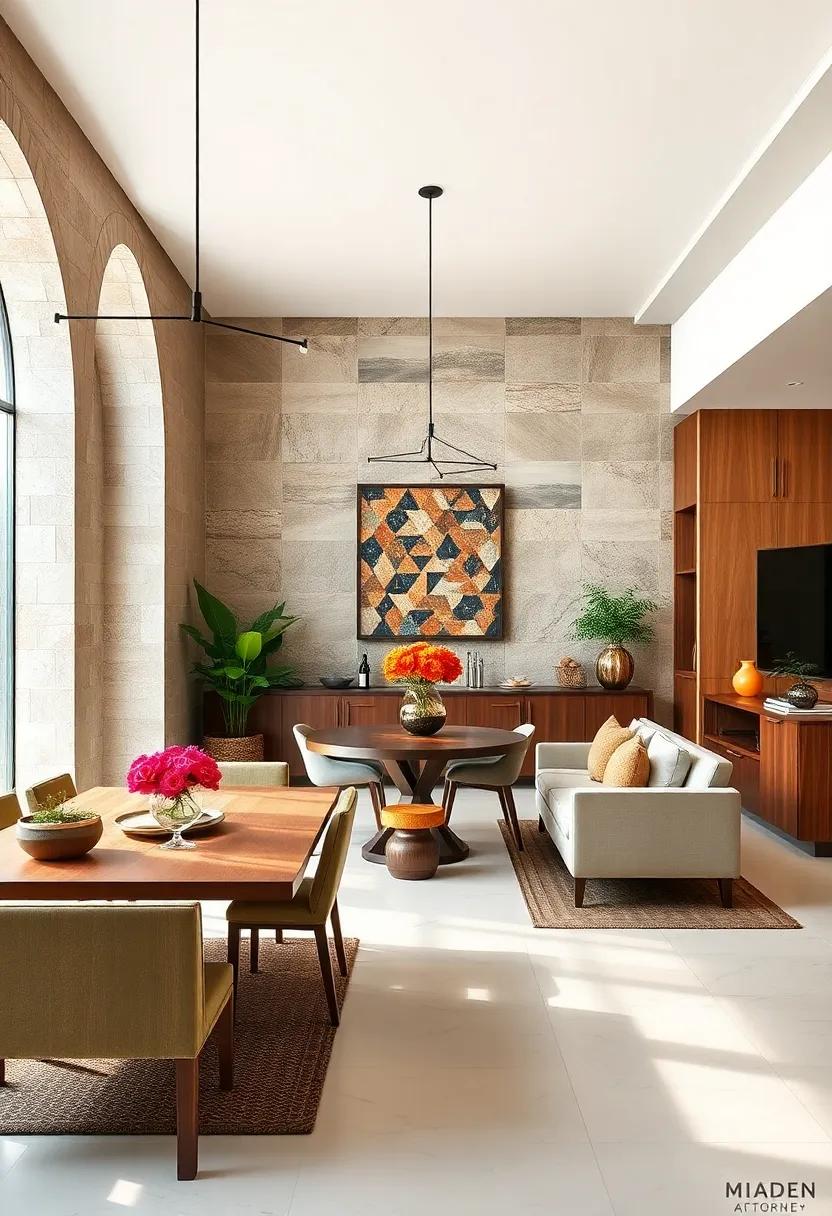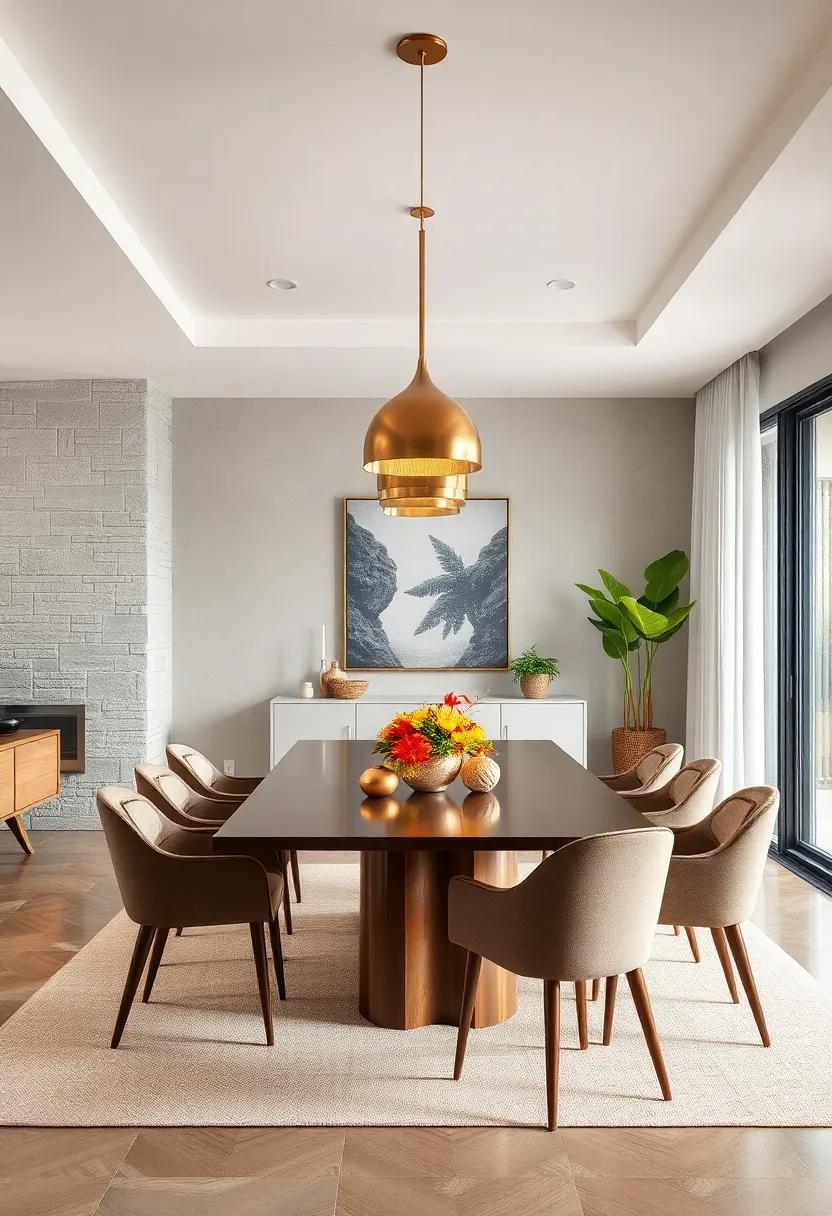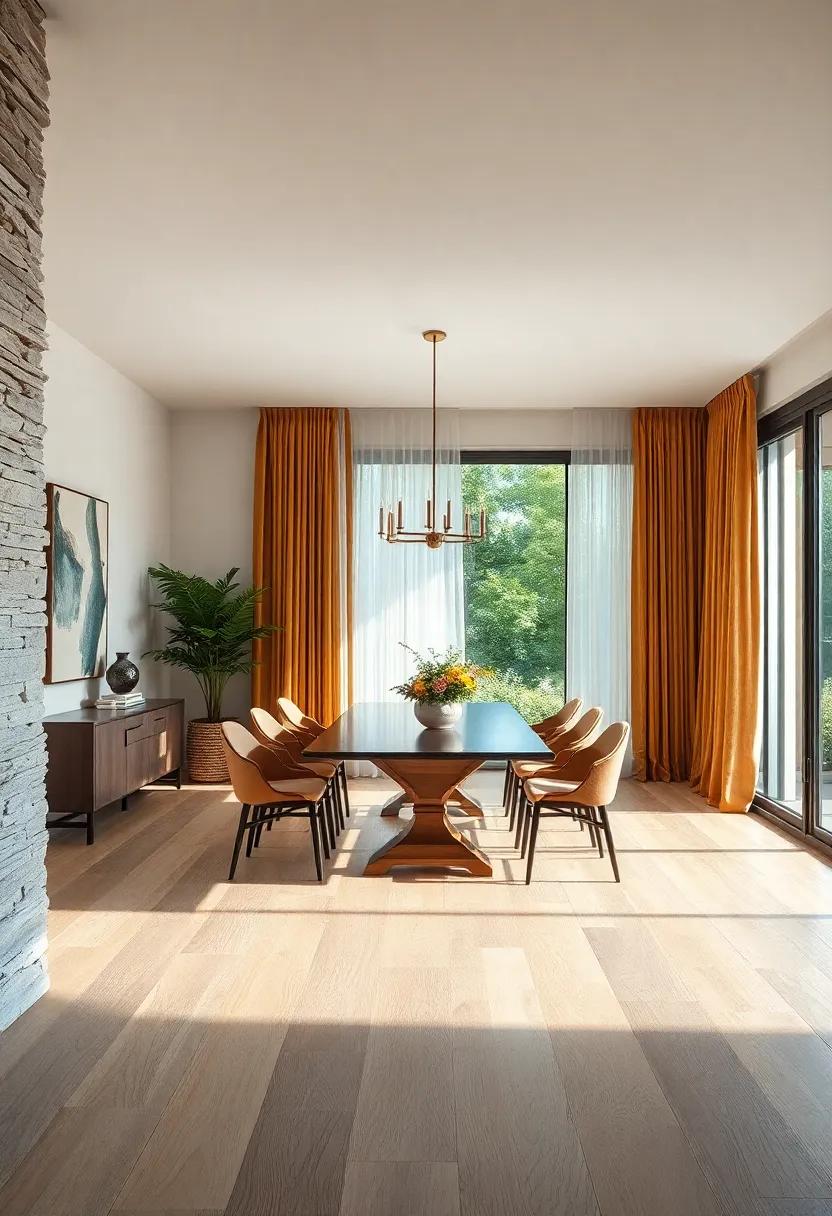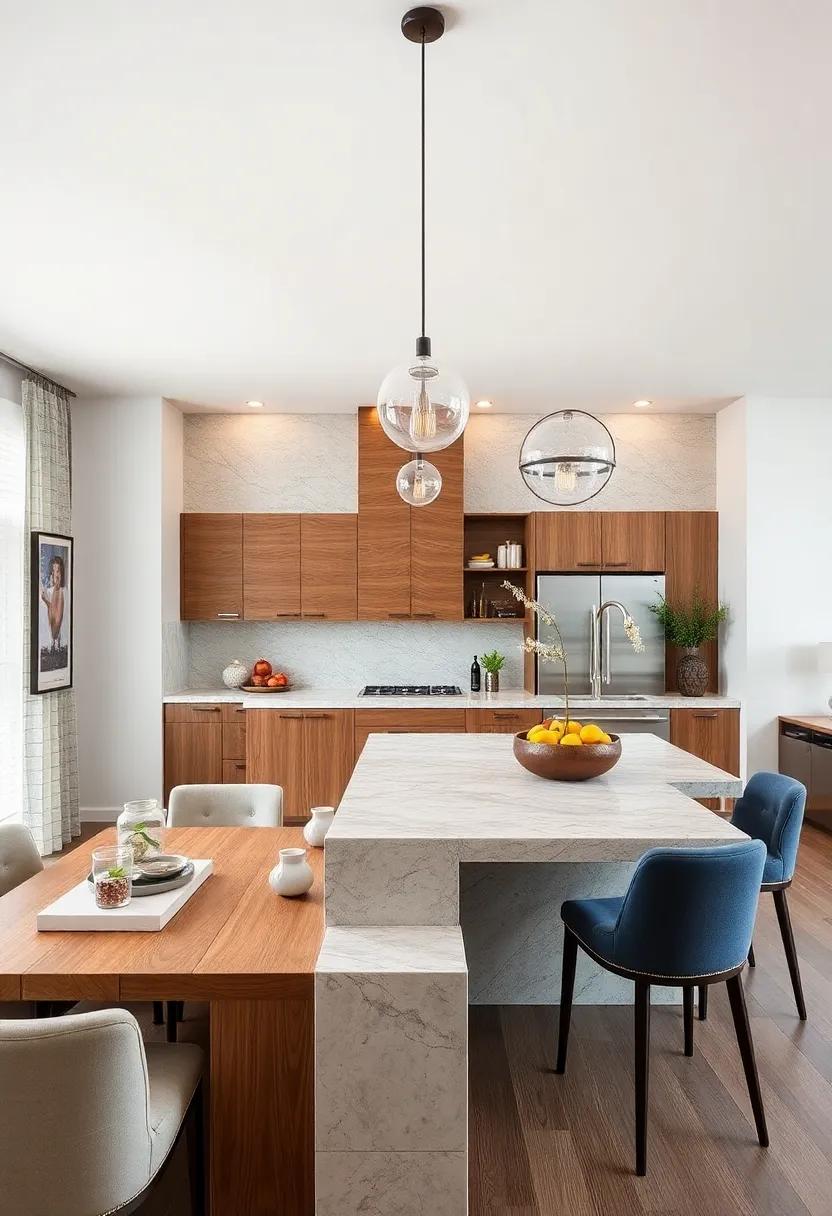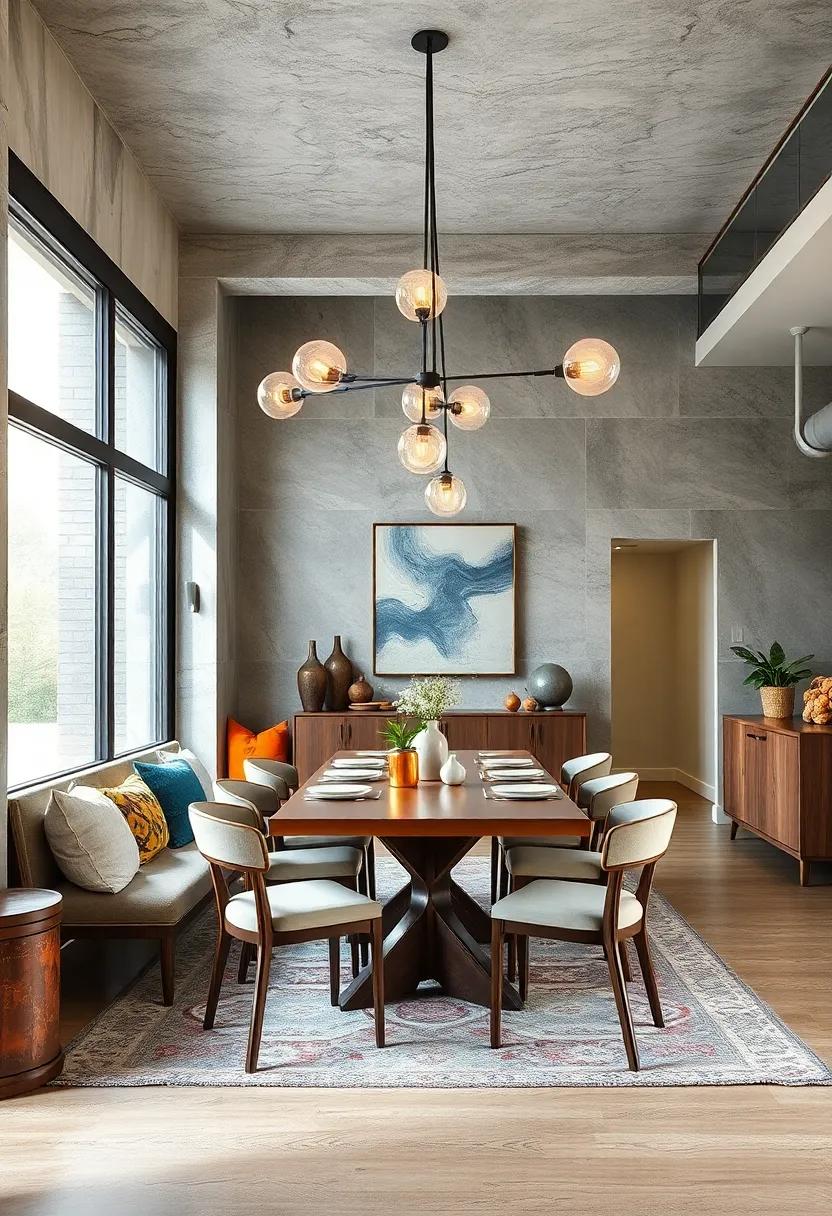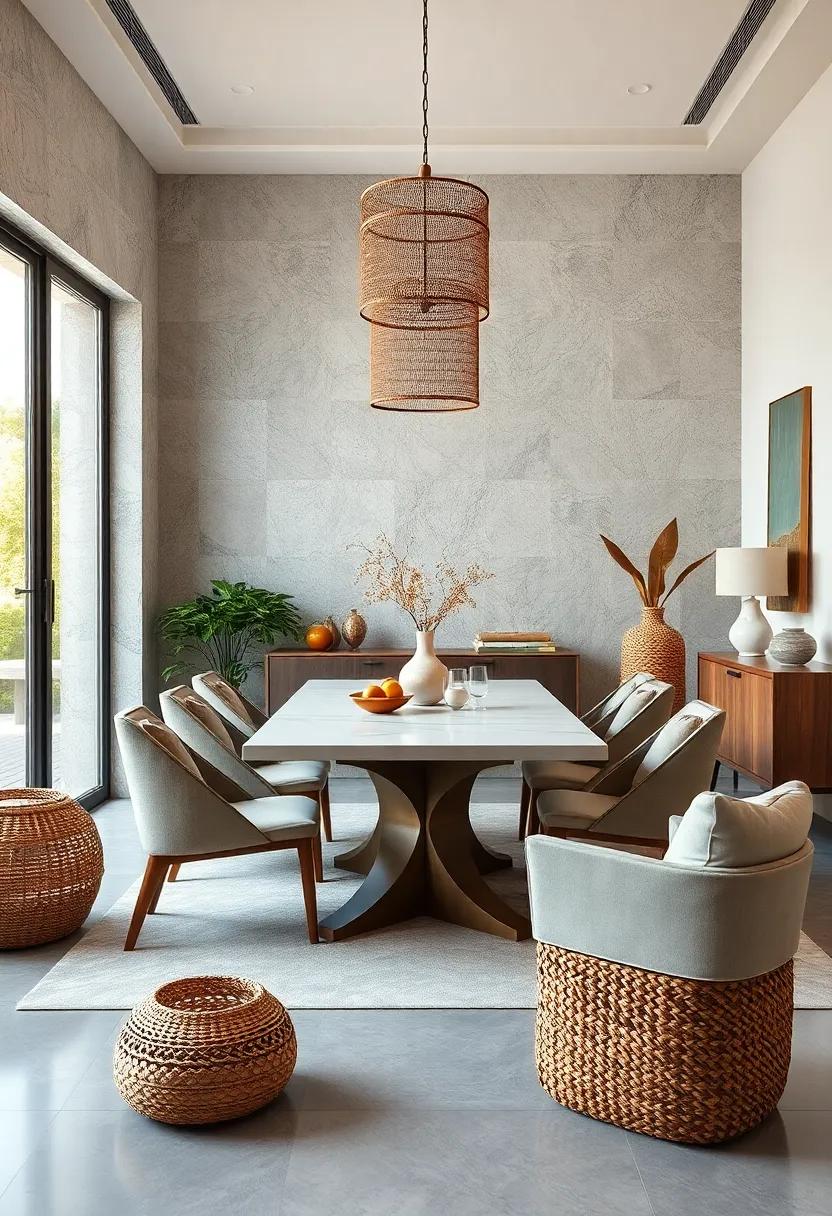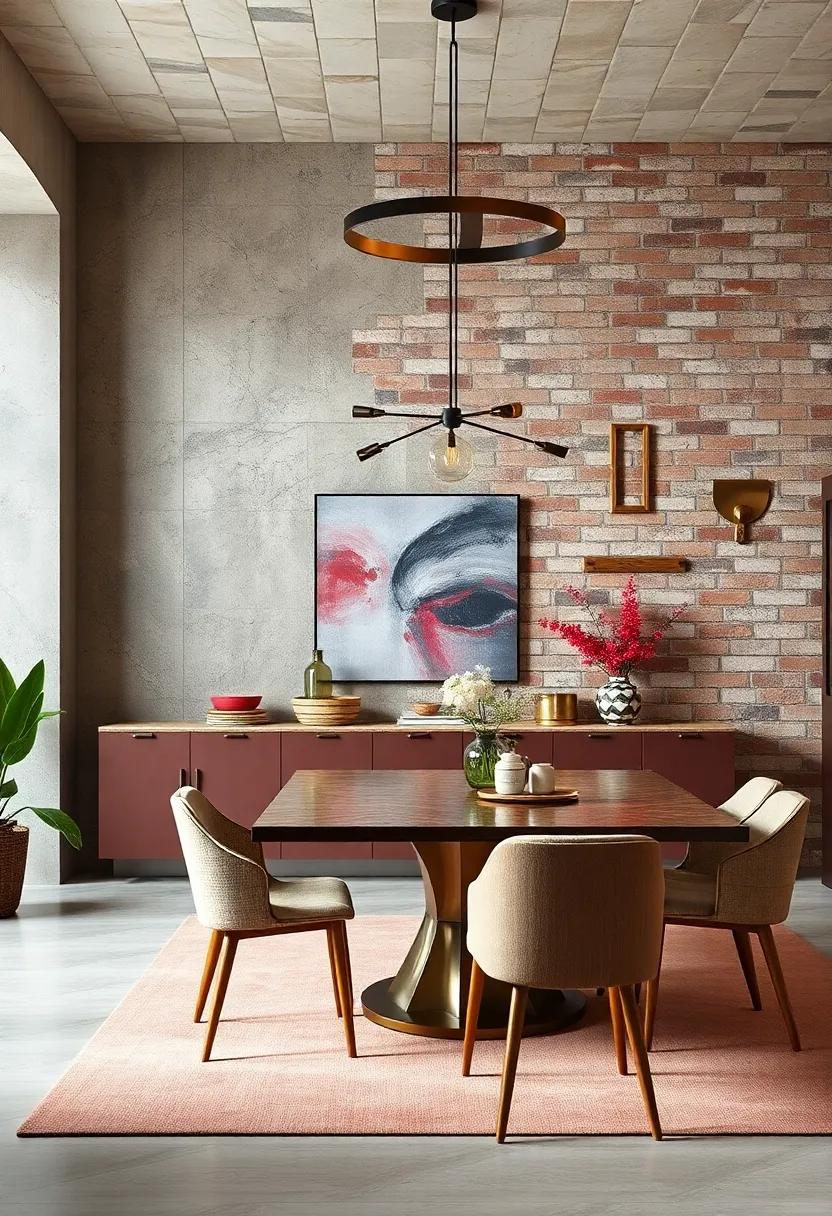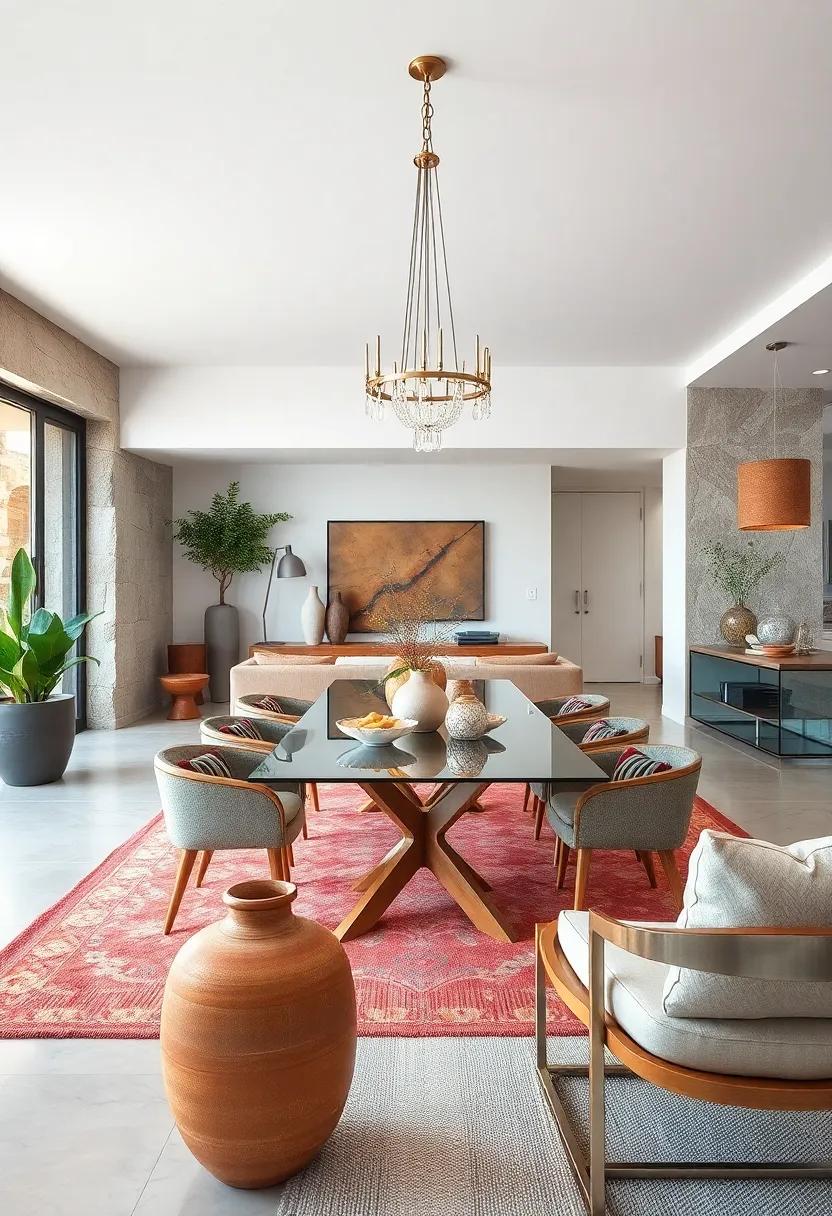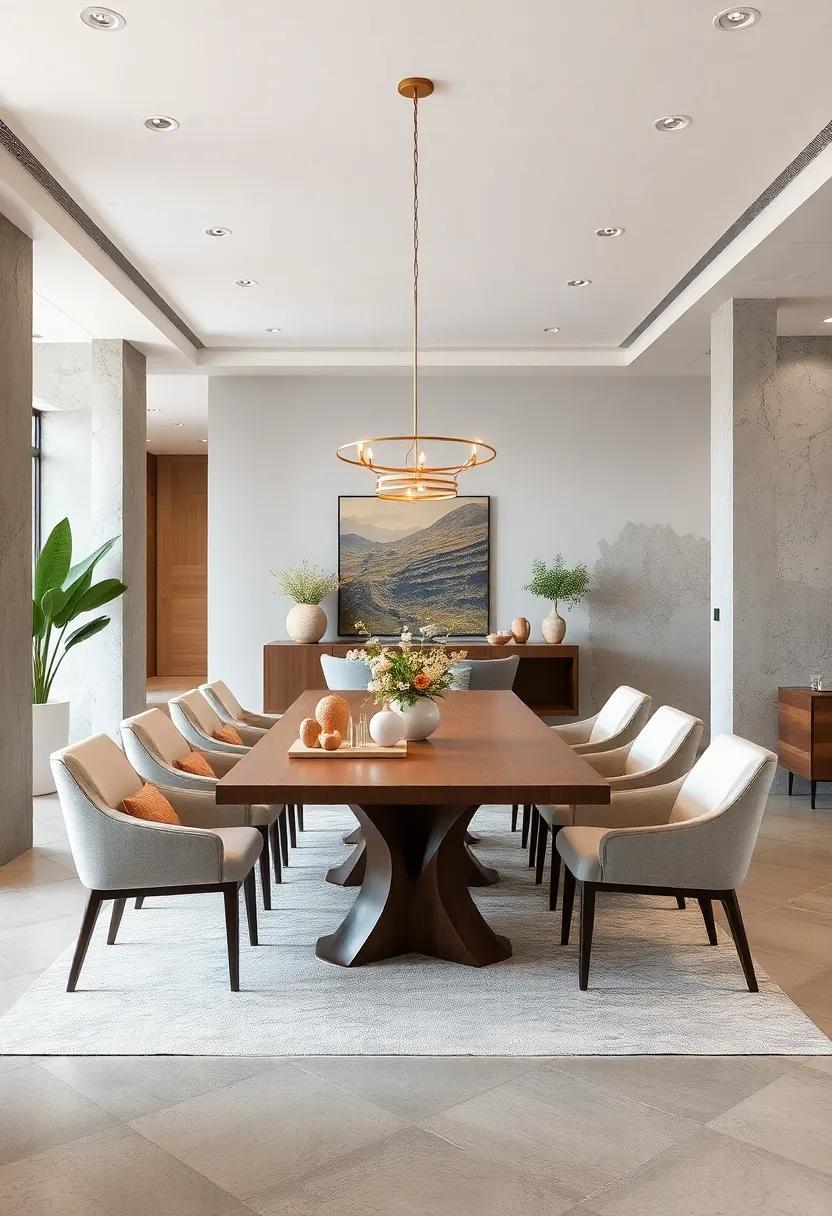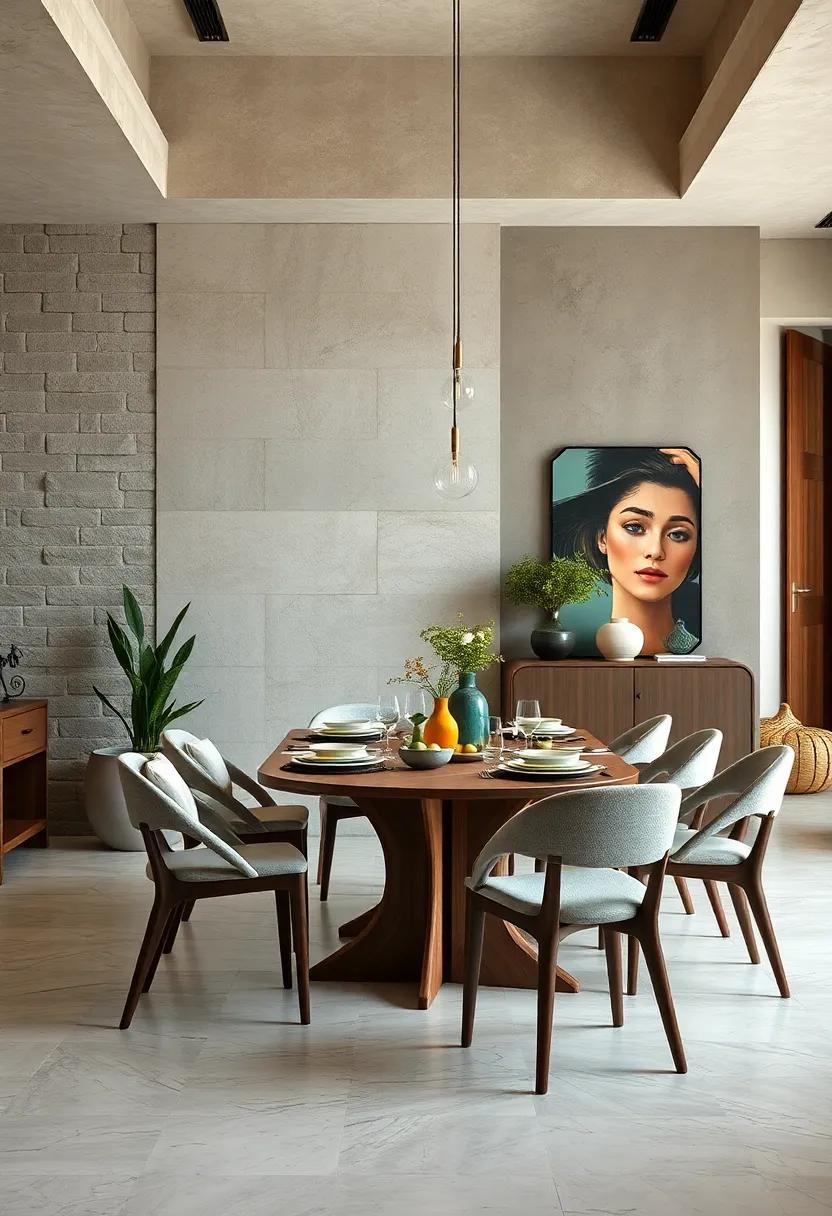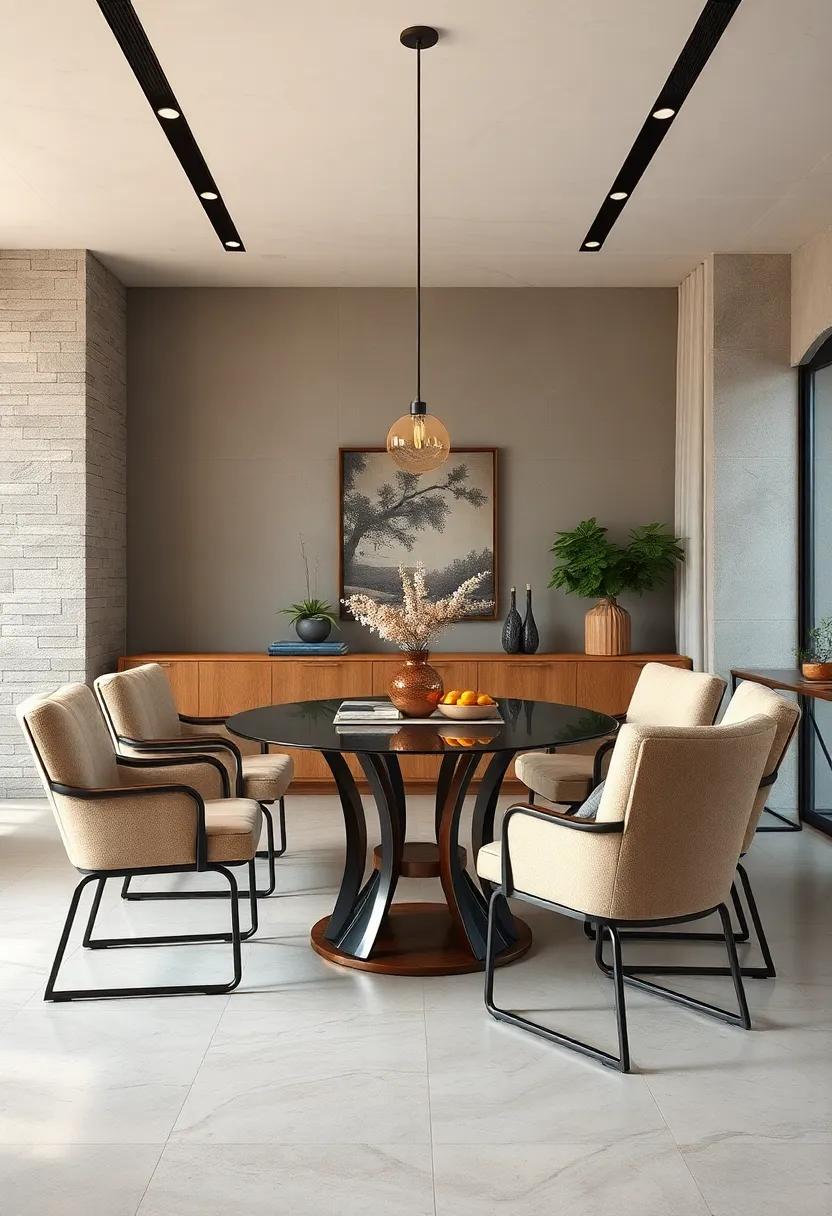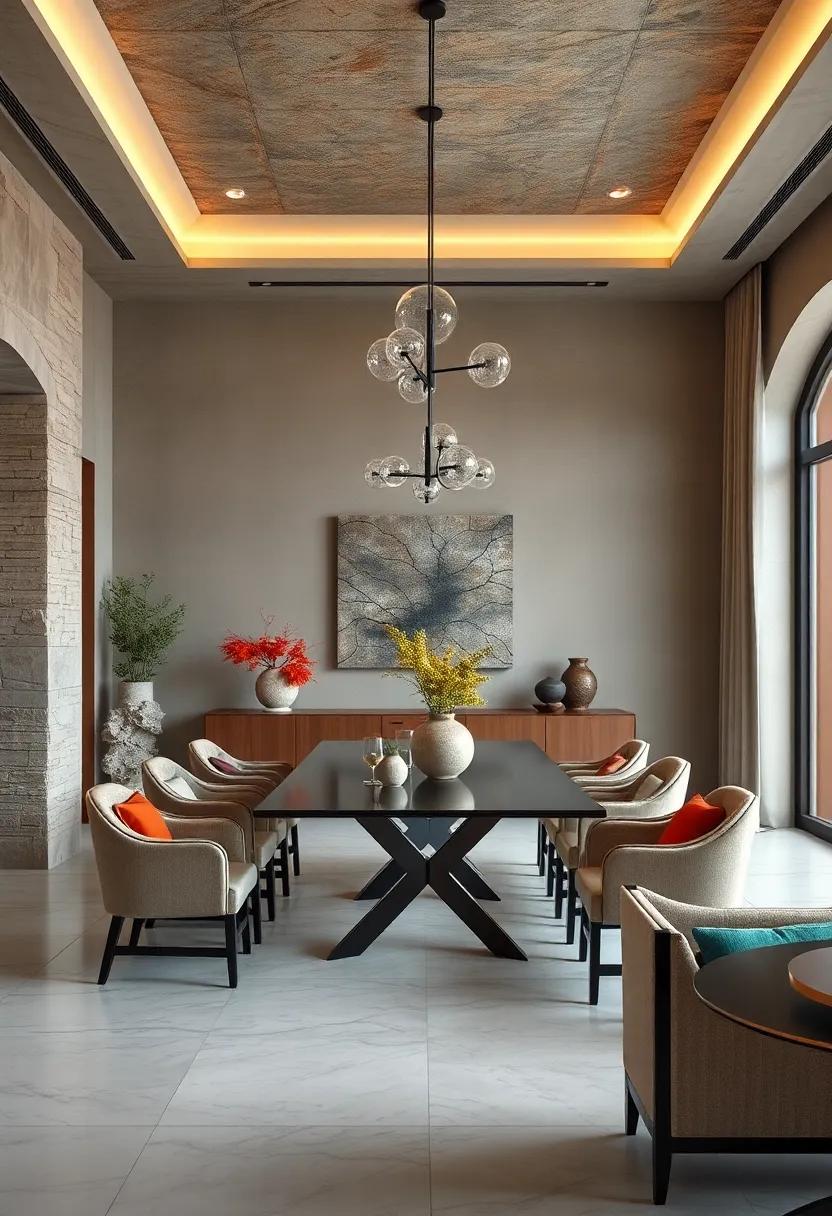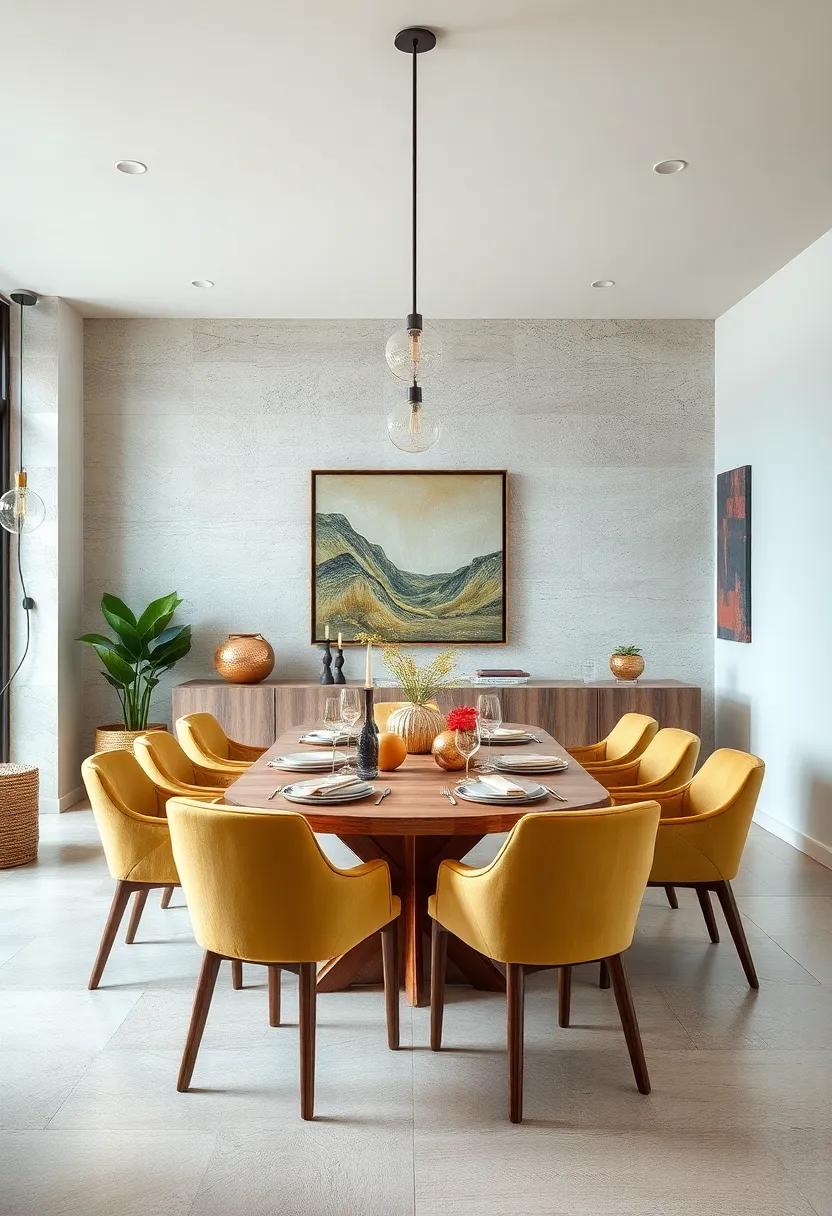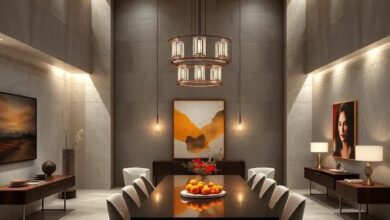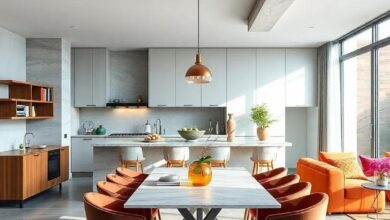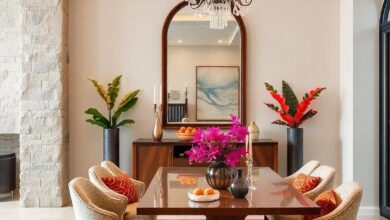Harmonizing Styles: Exploring Dining Rooms with Mixed Materials Magic
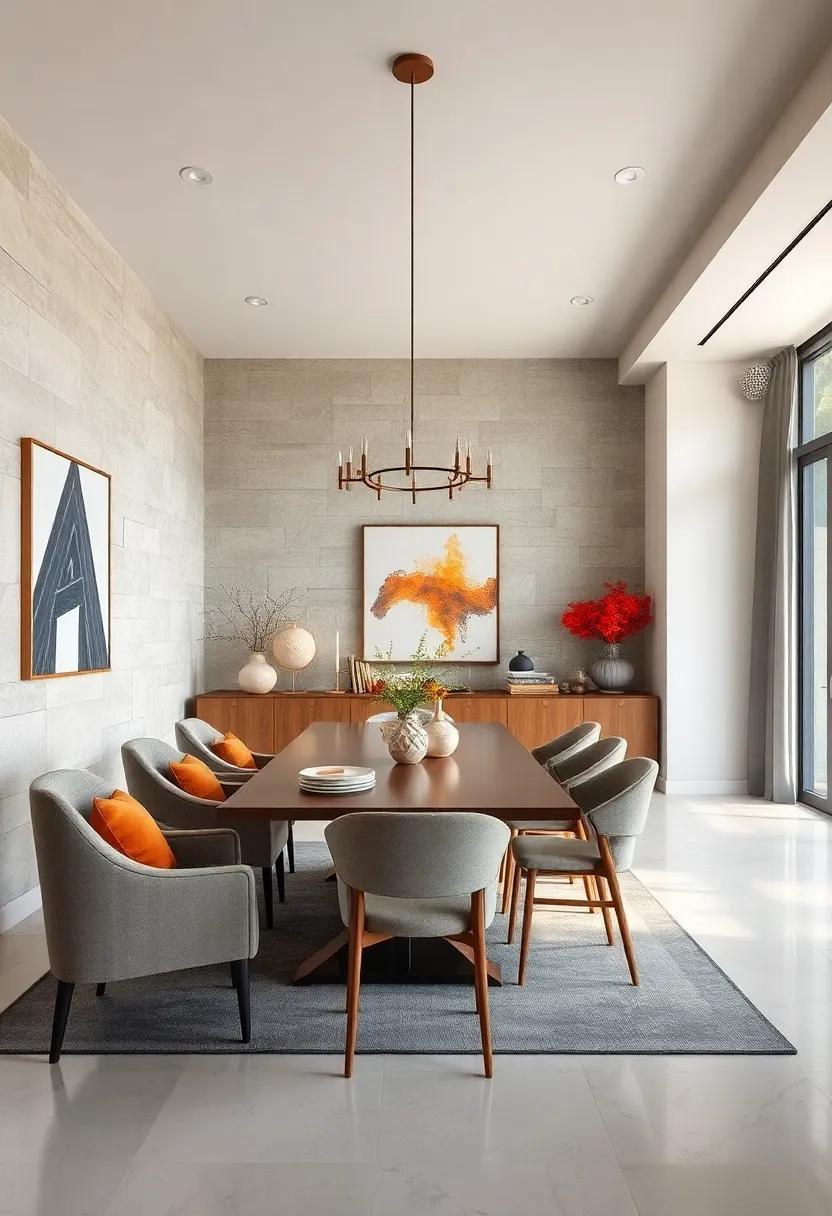
In the world of interior design, dining rooms serve as more than just places to share meals-they are stages where style and function come together in a delicate dance. Recently, a captivating trend has emerged that celebrates the beauty of contrast and cohesion alike: the art of mixing materials. From the warm grain of reclaimed wood to the sleek shimmer of metal, blending diverse textures and finishes invites a fresh kind of magic into our dining spaces. This exploration of harmonizing styles uncovers how combining materials can transform a room, creating environments that feel both dynamic and inviting. Join us as we delve into the creative possibilities and subtle intricacies of designing dining rooms where mixed materials weave stories of balance and beauty.
Blending Rustic Wood and Sleek Metals for a Balanced Dining Room Ambiance
Incorporating rustic wood alongside sleek metals creates a dynamic interplay that elevates the dining room’s character. The warmth and texture of reclaimed wood introduce an organic charm, while metals such as brushed steel or matte black frames add a contemporary edge. This fusion not only balances aesthetics but also enhances tactile experience, making every meal feel grounded yet modern. Imagine a sturdy oak table paired with chairs featuring slender metal legs-each element supports the other, fostering an environment both inviting and urbane.
Achieving this harmony involves:
- Choosing wood with visible grain and imperfections for authenticity
- Selecting metals with smooth, minimalist finishes to contrast natural textures
- Integrating accessories like metal pendant lights or wooden centerpiece bowls for cohesion
| Material | Effect | Best Use |
|---|---|---|
| Reclaimed Wood | Warmth and character | Dining tables and shelving |
| Brushed Steel | Modern sleekness | Chair legs and lighting fixtures |
| Matte Black Metal | Bold accent | Frames and hardware |
Capturing Warmth with Soft Fabrics and Rugged Stone Accents in Dining Spaces
Soft fabrics such as linen, velvet, and wool bring an inviting warmth to dining spaces, creating a cocoon of comfort that beckons guests to linger longer. These textiles absorb light and sound, adding layers of sensory richness that balance the sleek hardness of stone. Imagine plush, upholstered chairs paired with cushions in muted earth tones, their tactile surfaces juxtaposing the cool, unyielding textures of stone countertops or accent walls. This interplay is not just visual but almost poetic, inviting a sense of balance where softness meets strength in a harmonious embrace.
Stone accents – whether granite tabletops, marble inlays, or rugged slate flooring – introduce an element of timeless durability and raw beauty. Their natural variations in color and texture serve as a backdrop that elevates soft textiles, allowing each fabric’s weave and hue to truly stand out. Designers often utilize this dynamic through elements like:
- Stone pedestal bases paired with plush fabric-covered dining chairs
- Textured stone walls contrasting with lush window drapery
- Stone serving platters accented by woven linen napkins
| Material Pairing | Effect | Design Tip |
|---|---|---|
| Velvet & Slate | Soft meets edgy | Use jewel tones in cushions |
| Linen & Marble | Light & refined | Keep linens natural-colored |
| Wool & Granite | Cozy & robust | Combine with warm wood elements |
The Allure of Glass Tabletops Paired with Textured Concrete Bases in Dining Designs
There’s a distinct charm in combining the delicate transparency of glass with the rugged texture of concrete, creating dining tables that are both visually arresting and highly functional. The glass tabletop brings an airy openness, allowing light to flow freely and highlighting the bold, tactile nature of the concrete base. This pairing not only contrasts softness with solidity but also strikes a balance that encourages modern elegance without sacrificing warmth. It’s a design choice that invites curiosity, making every meal an experience framed by materials that speak to both industrial strength and refined sophistication.
Incorporating these elements into your dining space offers versatility with a dash of artistry. Consider how the textures and finishes complement various interior themes:
- Minimalist Vibes: Smooth, polished glass with a raw, matte concrete base forms a sleek silhouette that enhances clean lines and understated decor.
- Rustic Meets Modern: Textured or distressed concrete paired with slightly tinted or frosted glass adds depth and character, blending heritage and contemporary styles seamlessly.
- Industrial Chic: Combine rough concrete with thick, beveled glass edges to amplify an urban, loft-inspired dining atmosphere that’s both edgy and approachable.
| Material Aspect | Status | Effect |
|---|---|---|
| Glass Top | Clear or Tinted | Illusion of space and lightness |
| Concrete Base | Polished or Textured | Anchor and visual grounding |
| Edge Details | Beveled or Raw | Balance between refinement and boldness |
Contrasting Matte Black Fixtures Against Polished Brass for Dining Room Drama
Injecting a bit of flair into your dining space is effortlessly achieved by pairing matte black fixtures with the gleaming allure of polished brass. The matte black’s deep, muted tones create a grounding effect, allowing the polished brass to shine as a luminous accent. This combination fosters an intriguing visual tension, where the modern edge of black matte meets the timeless sophistication of brass, making every meal feel like a curated experience. Whether it’s the sleek lines of black pendant lights or the refined curves of brass cabinet handles, these elements harmonize to elevate the room’s ambiance.
- Matte Black: Adds depth, modernity, and contrasts boldly.
- Polished Brass: Introduces warmth, luxury, and vintage charm.
- Balance: Use black as a backdrop with brass as focal points for striking drama.
| Fixture Type | Matte Black | Polished Brass |
|---|---|---|
| Light Fixture | Industrial Pendant | Ornate Chandelier |
| Hardware | Simple Knobs | Intricate Pulls |
| Decorative Element | Wall Candle Holder | Centerpiece Vase |
Strategic placement of these materials can subtly guide the eye and define spaces within the dining area. Incorporating matte black fixtures for structural elements like frames or legs enhances the foundation, while polished brass accents can highlight key features such as a buffet or a statement mirror. This juxtaposition invites guests to appreciate the interplay of textures and finishes, adding layers of visual interest without overwhelming the senses. The result is a dining room that’s not just functional but brimming with personality and depth.
Layering Natural Fibers with Industrial Elements to Enrich Dining Room Atmosphere
Bringing together the warmth of natural fibers such as jute, linen, and cotton with the sleek, robust quality of industrial materials like steel, concrete, and reclaimed wood creates a dynamic visual and tactile experience in the dining room. This juxtaposition not only enhances the room’s aesthetic appeal but also stimulates a sensory richness. Imagine plush linen seat cushions paired with rugged steel chair frames or a coarse jute table runner lying atop a polished concrete tabletop-each element playing off the other to craft a balanced yet intriguing atmosphere. These combinations celebrate texture and form, making every meal feel thoughtfully curated and inviting.
Strategically layering materials also opens up a range of design opportunities, encouraging creativity in both function and form. Here are some key benefits of mixing natural fibers with industrial components:
- Enhanced durability: Industrial materials add fortitude, while fibers provide comfort and softness.
- Balanced ambiance: The natural textures soften the coldness of metals and stone.
- Visual depth: Varied textures create layers that engage the eye and invite touch.
- Sustainability: Combining reclaimed industrial elements with organic fibers promotes eco-conscious design.
Mixing Vintage Ceramics and Modern Minimalism in the Dining Room Setting
Combining the warmth of vintage ceramics with the sleek simplicity of modern minimalism creates a dining room ambiance that is both inviting and refreshingly clean. Think sun-kissed terracotta plates paired alongside stark white matte dinnerware, or delicate floral-patterned bowls juxtaposed against minimalist black cutlery. This intentional contrast encourages a dialogue between eras, generating a curated aesthetic that feels authentic and lived-in yet uncluttered. Embracing asymmetry through mismatched ceramic pieces enhances this eclectic vibe, making each meal a visual and tactile experience that honors both texture and form.
- Color Harmony: Muted earth tones paired with monochrome accents balance vintage charm with contemporary calm.
- Material Contrast: Rough-glazed pottery complements smooth, glossy surfaces to entice the senses.
- Functional Art: Ceramics become statement pieces when arranged strategically around minimalistic furniture.
| Element | Vintage Ceramics | Modern Minimalism |
|---|---|---|
| Shape | Organic, irregular | Geometric, clean lines |
| Color | Warm, natural hues | Neutral, monochrome shades |
| Texture | Textured, tactile | Smooth, matte |
Elevating Dining Experiences with Marble Surfaces Amidst Raw Wooden Surroundings
Marble surfaces add a refined touch of elegance that beautifully contrasts with the organic textures of raw wooden surroundings. Their smooth, polished finish not only enhances the aesthetic appeal but also brings a subtle coolness underfoot, creating a sensory balance within the dining space. The natural veining patterns in marble act as artistic focal points that draw the eye, elevating the overall ambiance without overpowering the warmth of timber elements.
Incorporating marble in dining areas amidst wood introduces a sophisticated interplay of materials, which results in spaces that feel both luxurious and inviting. Consider these design benefits:
- Visual Contrast: The sleek surface of marble juxtaposed against rough-hewn wood amplifies depth and dimension.
- Durability: Marble withstands daily use and is resistant to heat, making it perfect for dining tables and countertops.
- Versatility: Marble complements various wood finishes, from light oak to deep walnut, enriching diverse decorating styles.
The Charm of Reclaimed Wood Meets Contemporary Metal Chairs in Dining Interiors
Combining the rustic allure of reclaimed wood with the sleek edge of contemporary metal chairs creates a dining space that is both inviting and dynamic. The natural imperfections and rich textures of reclaimed wood add warmth and character, grounding the room in a sense of history and authenticity. Meanwhile, metal chairs bring in a modern, industrial vibe that contrasts beautifully without overwhelming the organic elements. This interplay of materials fosters a balanced environment where tradition embraces innovation, making every mealtime an experience that feels uniquely curated.
To achieve this look effortlessly, consider these styling tips:
- Mix finishes: Pair matte metal finishes with warm wood tones to enhance contrast.
- Balance proportions: Choose chairs with slim profiles to keep the space airy alongside chunky reclaimed wood tables.
- Add soft textiles: Cushions or throws in natural fibers soften the metal’s coolness and add cozy layers.
| Element | Effect | Tip |
|---|---|---|
| Reclaimed Wood Table | Rustic warmth and texture | Highlight natural grain |
| Metal Chairs | Modern sleekness | Opt for matte finishes |
| Cushions | Comfort and softness | Choose neutral tones |
Juxtaposing Smooth Leather Seating with Rough Linen Drapes for Textural Harmony
Pairing the silky finish of smooth leather seating with the inherently tactile, rustic feel of rough linen drapes crafts a sensory masterpiece within any dining room. The leather invites a sleek, polished touch while the linen introduces an organic warmth and effortless charm. This interplay between the two materials doesn’t just elevate aesthetics-it creates a dynamic that’s comfortable yet sophisticated, grounding the space with contrast and complement simultaneously. Using leather with its glossy resilience alongside linen’s soft, matte texture allows each to shine distinctly, offering visual interest and interactive depth that captivates visitors at first glance.
Incorporating these materials thoughtfully involves considering their maintenance, color harmony, and placement. For instance, choosing linens in muted earthy tones can amplify the leather’s rich hues without overpowering them. To guide your design balance, here’s a quick overview:
| Material | Texture | Suggested Color Palette | Care Tips |
|---|---|---|---|
| Smooth Leather | Glossy, sleek | Deep browns, charcoals, blacks | Regular conditioning; avoid direct sunlight |
| Rough Linen | Matte, tactile | Natural beiges, soft greys, muted greens | Gentle washing; air dry recommended |
Blending plush leather chairs with loosely draped linen curtains invites a lived-in luxury feel, proving that contrasts in texture foster a balanced, inviting, and distinctly stylish dining environment.
Incorporating Bold Patterns on Upholstery Alongside Simple Wooden Furniture
Introducing bold patterns on upholstery can be a transformative way to inject character and vibrancy into a dining room without overwhelming the space. When paired with simple wooden furniture, these lively textiles bring a layer of tactile and visual intrigue, making each piece stand out while maintaining a cohesive look. Think of chairs adorned with geometric prints, florals, or stripes that contrast beautifully with the natural grain of wood, balancing both rustic charm and modern flair. The unpretentious elegance of wood acts as a calming backdrop, allowing patterned fabrics to take center stage, adding personality and warmth to your dining experience.
To master this blend, consider incorporating the following design approaches:
- Color Coordination: Select upholstery patterns that reflect colors subtlety echoed in the wooden tones or room accents to create harmony.
- Texture Play: Combine smooth wooden finishes with richly textured fabrics like velvet or linen to heighten sensory interest.
- Pattern Scale: Use larger patterns on key pieces and smaller, complementary patterns on secondary seating to avoid visual chaos.
| Pattern Type | Wood Finish | Effect |
|---|---|---|
| Bold Geometrics | Light Oak | Fresh, contemporary feel |
| Vibrant Florals | Rich Walnut | Warm, inviting atmosphere |
| Classic Stripes | Natural Pine | Timeless, casual elegance |
Using Colorful Tile Insets to Complement Earthy Tones in Dining Room Walls
Incorporating vibrant tile insets into dining room walls adorned with earthy tones introduces an unexpected yet harmonious contrast. These colorful accents break up the monochromatic warmth of terracotta, ochre, or muted browns, infusing the space with a playful vibrancy that enlivens every meal. Tiles in jewel tones like deep turquoise, emerald, or burnt sienna offer focal points that naturally guide the eye, creating a dynamic rhythm along the wall without overpowering the subtle organic palette. The glossy finish of tiles also adds a tactile dimension, making the walls not just a backdrop but an interactive feature that complements rustic wooden furniture or woven textile elements.
When choosing tile patterns and colors, keep in mind the balance between boldness and cohesion. Here’s a quick guide to mixing tile inset hues with common earthy wall shades:
| Wall Color | Suggested Tile Colors | Effect |
|---|---|---|
| Soft Clay | Teal, Mustard Yellow | Warm & Inviting Contrast |
| Sandy Beige | Coral, Olive Green | Earthy with a Touch of Freshness |
| Rich Brown | Burnt Orange, Cobalt Blue | Bold & Elegant Pop |
- Mix textures: Glossy tiles meet matte walls for depth.
- Repeat colors: Pull tile inset shades into rugs or cushions.
- Scale wisely: Small tile patterns prevent overwhelming the natural hues.
This combination invites creativity in the space without sacrificing the warmth and comfort essential to dining rooms, making every gathering feel both grounded and visually inspiring.
Harmonizing Translucent Acrylic Chairs with Solid Wood Tables for Modern Flair
Blending translucent acrylic chairs with robust solid wood tables creates an exquisite balance between lightness and earthiness, infusing any dining space with a modern yet inviting aura. The clear, sleek nature of acrylic furniture offers unobstructed views of the wood’s intricate grains, allowing the table’s natural beauty to shine while adding an airy feel. This interplay makes the room appear more spacious and visually appealing, especially when accented with soft lighting and minimalist décor.
To maximize this harmonious effect, consider these styling tips:
- Contrast Textures: Pair gloss-finished acrylic chairs with matte or distressed wood tables to add depth and interest.
- Neutral Palettes: Use subtle color schemes like soft grays, beiges, or whites to keep the focus on the material interaction.
- Metallic Accents: Incorporate brass or black metal fixtures for a touch of industrial chic that complements both materials.
| Material | Effect | Design Tip |
|---|---|---|
| Acrylic Chairs | Light & Airy | Choose rounded edges for softness |
| Solid Wood Table | Warm & Earthy | Opt for reclaimed wood to embrace rustic charm |
| Metal Accents | Sharp & Modern | Use matte finishes for subtle sophistication |
Combining Metallic Pendant Lights and Organic Centerpieces in Dining Room Design
Metallic pendant lights bring a sleek, contemporary edge to dining rooms, effortlessly catching the eye with their polished surfaces and reflective qualities. When paired with organic centerpieces-such as lush greenery, wooden bowls, or hand-crafted ceramics-this combination creates an irresistible contrast that breathes warmth and balance into the space. The cool, industrial shine of metals like brass, copper, or matte black provides a striking counterpoint to the softness and tactile appeal of natural elements, resulting in a visually dynamic yet harmonious dining environment.
To maximize the impact of this mixed-materials approach, consider these styling tips:
- Vary textures: Balance smooth metallic finishes with rough-hewn or textured organic pieces to add depth.
- Mind the scale: Choose pendant lights and centerpieces that complement rather than compete with each other in size.
- Color coordination: Use the warmth of metals to highlight the earthy tones of your organic centerpiece for a cohesive vibe.
- Layer light and life: Mix ambient lighting from pendants with natural elements to create an inviting, multisensory experience.
Bleached Wood Floors Paired with Rich Velvet Curtains to Inspire Relaxed Elegance
The subtle charm of bleached wood floors creates an airy foundation that effortlessly complements the lush texture of rich velvet curtains. This pairing invites a serene atmosphere where light gracefully bounces across the space, softening edges and enhancing natural hues. The floors’ pale tones act as a neutral canvas, allowing the deep, sumptuous colors of velvet to take center stage. Together, they strike a balance between cool minimalism and cozy opulence, turning any dining room into a sanctuary of relaxed elegance.
Integrating these elements opens up exciting possibilities for layering with other materials and finishes. Consider incorporating:
- Matte black metal accents to anchor the softer textures with modern structure.
- Reflective glass or mirrored surfaces to amplify light and add a hint of glamor.
- Natural woven textiles to introduce an organic, tactile contrast that warms the space.
This blend not only elevates the dining experience but also encourages a harmonious interplay between rustic charm and refined sophistication, inviting guests to linger longer in comfort and style.
Mixing Brushed Stainless Steel with Natural Stone Countertops for Culinary Sophistication
Infusing brushed stainless steel with natural stone countertops creates a stunning juxtaposition that elevates any culinary space. The tactile coolness and sleek, matte finish of stainless steel effortlessly contrast the organic warmth and intricate veins of granite, marble, or quartz. This blend not only amplifies visual interest but also introduces a balanced harmony, where industrial modernity meets earthy sophistication. Such combinations are perfect for those who appreciate timeless elegance with a dash of contemporary flair. Through the reflective surfaces and raw textures, kitchen islands, backsplashes, and food prep areas become functional art pieces that invite both cooking and conversation.
To maximize this fusion, consider integrating elements that complement both materials and enhance unity:
- Lighting: Utilize pendant lights with brushed steel finishes to echo the countertop’s metallic sheen.
- Hardware: Choose cabinet handles and faucets in stainless steel to tie the visual narrative together.
- Color palette: Incorporate muted earth tones and soft neutrals in surrounding furniture and accessories.
| Material | Characteristic | Benefit in Kitchen Design |
|---|---|---|
| Brushed Stainless Steel | Matte, Reflective | Durability & Modern Aesthetic |
| Natural Stone | Textured, Unique Veining | Warmth & Timeless Appeal |
Fusing Mid-Century Modern Elements with Industrial Lighting in Dining Areas
Blending mid-century modern design with industrial lighting in dining rooms creates a dynamic balance between sleek sophistication and raw, utilitarian charm. The iconic clean lines and organic curves of mid-century furniture serve as a perfect canvas for the bold, often stark features of industrial fixtures. Imagine a teak wood dining table paired with vintage-inspired metal pendant lamps suspended overhead, their exposed bulbs casting an inviting glow that enhances the textured contrasts in the space. The marriage of wood and metal not only celebrates the authenticity of materials but also introduces a tactile dialogue that uplifts the entire dining experience.
To successfully harmonize these elements, focus on complementary textures and finishes. Incorporate:
- Warm wood tones that echo mid-century warmth
- Brushed or matte metals which soften the industrial edge
- Muted color palettes to keep the atmosphere cozy and unified
- Simple geometric shapes to anchor the space visually
Here’s a quick guide to pairing lighting styles with furniture pieces, crafted for those looking to expertly balance both aesthetics:
| Mid-Century Piece | Suggested Industrial Lighting | Effect |
|---|---|---|
| Elliptical Walnut Sideboard | Black Cage Pendant | Juxtaposes organic form with geometric rawness |
| Tapered Leg Dining Chairs | Antique Brass Sconce | Adds warmth and subtle metallic shimmer |
| Minimalist Glass-Top Table | Exposed Edison Bulbs Cluster | Creates radiant contrast and vintage flair |
Exploring Layered Textures Through Woven Baskets and Smooth Marble Accents
Introducing woven baskets alongside smooth marble accents creates an exquisite tactile interplay that elevates dining room aesthetics. The natural fibers of the baskets bring warmth, organic texture, and a handcrafted charm, while the polished marble surfaces contribute a sleek, cool sophistication. Together, they form a complementary contrast that invites touch and admiration. This blend not only enriches visual interest but also balances the rustic and refined, proving that diverse materials can coexist in serene harmony.
Consider incorporating elements like:
- Wicker storage baskets for a casual, earthy feel
- Marble-topped dining tables that anchor the space with elegance
- Textured wall art or placemats combining both materials for continuity
Below is a simple guide to using these materials effectively:
| Material | Design Role | Effect |
|---|---|---|
| Woven Basket | Accent & Storage | Warmth & Texture |
| Marble | Surface & Centerpiece | Cool Elegance & Shine |
By thoughtfully layering these elements, you create spaces that feel both inviting and polished-an artful balance that breathes personality and sophistication into every meal.
Contrasting Glossy Lacquer Cabinets with Rustic Brick Backdrops in Dining Rooms
Glossy lacquer cabinets bring a sleek, polished sheen that immediately elevates the dining room with a contemporary vibe. Their smooth, reflective surfaces bounce light across the room, creating an airy and spacious feel that contrasts starkly with the textured, timeworn charm of rustic brick walls. This juxtaposition isn’t just about opposing aesthetics but about crafting a dialogue between modernity and heritage. The lacquer’s clean lines and glossy finish heighten the visual drama, making each meal a stylish occasion framed by bold material interplay.
When pairing these two elements, consider subtle accents to bridge the gap:
- Metal fixtures in matte black or antique brass, which complement both gloss and brick
- Warm wood accessories to soften the industrial edge
- Neutral textiles that anchor the space without overwhelming either element
Below is a quick comparison of how these materials impact the room’s mood and functionality:
| Feature | Glossy Lacquer Cabinets | Rustic Brick Backdrops |
|---|---|---|
| Visual Appeal | Shiny, reflective, modern | Textured, earthy, vintage |
| Maintenance | Easy to wipe clean | Requires occasional dusting and sealing |
| Ambience | Bright, chic, polished | Cozy, warm, rugged |
| Durability | Scratch prone but resilient | Highly durable and long-lasting |
Showcasing Handcrafted Pottery Amid Sleek Glass and Steel Furnishings
In the world of modern interiors, the marriage between handcrafted pottery and sleek glass and steel furnishings creates a compelling narrative of contrasts. The earthy textures and organic imperfections of pottery pieces invite a tactile warmth that breaks the monotony of polished surfaces. These handcrafted artifacts stand as unique focal points, turning a minimalist dining setting into a curated gallery where every bowl, vase, or plate tells a story deeply rooted in tradition and artisanal mastery.
Integrating these materials requires a thoughtful approach. Consider the following when blending pottery with modern elements:
- Balance: Position larger ceramic vessels near linear steel accents to soften the industrial effect.
- Contrast: Use clear glass to highlight the rich textures and muted tones of clay.
- Repetition: Repeat pottery elements in different shapes or colors to create visual rhythm across the dining space.
| Element | Effect | Tip |
|---|---|---|
| Handcrafted Pottery | Adds warmth and uniqueness | Use in clusters for a dramatic statement |
| Glass Surfaces | Creates lightness and reflection | Place pottery on glass to enhance texture visibility |
| Steel Furnishings | Injects sleek modernity | Pair with warm pottery tones to avoid coldness |
Blending Soft Pastels with Raw Concrete to Create Subtle Contrast in Dining Environments
When introducing elements as distinct as soft pastels and raw concrete into dining spaces, the key lies in achieving visual harmony without overwhelming the senses. Soft pastel hues-like blush pinks, muted blues, and gentle greens-introduce a whisper of color that breathes warmth and softness into the room. These tones beautifully balance the rugged, unrefined texture of raw concrete, whose cool gray and tactile presence ground the ambiance. Together, this duo creates a layered environment where each material elevates the other, fostering a subtle contrast that feels both contemporary and cozy.
Key strategies to blend these materials effectively include:
- Using concrete for structural elements such as walls, tabletops, or flooring to maintain an understated, industrial backbone.
- Introducing soft pastels through textiles-curtains, cushions, or chairs-to add a gentle layer of color and comfort.
- Incorporating complementary natural materials like light wood or rattan to soften the transition between hard and soft textures.
- Balancing lighting to enhance the pastel tones during the day and to accentuate concrete’s texture by night.
| Element | Material/Color | Effect |
|---|---|---|
| Dining Table | Raw Concrete | Industrial texture & weight |
| Upholstery | Soft Pastel Fabric | Comfort & subtle vibrancy |
| Wall Finish | Matte Pastel Paint | Soft backdrop enhancing contrast |
| Accent Pieces | Natural Wood | Organic warmth bridging textures |
Unifying Ceramic Tableware Styles with Wooden Dining Sets for Visual Interest
Introducing ceramic tableware alongside wooden dining sets offers a dynamic visual interplay that elevates the dining atmosphere. The natural warmth of wood complements the sleek, often glossy finish of ceramics, creating a rich textural contrast that invites closer inspection. Mixing modern, minimalist ceramic pieces-think matte finishes and subtle patterns-with rustic or vintage wooden tables brings balance and cohesion without sacrificing individuality. Such combinations encourage the eye to move fluidly across the table, enriching the dining experience through layered aesthetics.
To seamlessly integrate these mixed materials, consider key pairing strategies:
- Color Harmony: Use neutral or earth tones in ceramics to echo the wooden hues.
- Shape Contrast: Combine the rigid, geometric forms of wooden furniture with organic, rounded ceramic shapes.
- Texture Variety: Offset the smoothness of ceramics with the grainy surface of wood for tactile interest.
| Material | Visual Effect | Example |
|---|---|---|
| Light Oak Wood | Warm, inviting base | Raw edge dining table |
| Matte White Ceramic | Clean, modern contrast | Minimalist plates & bowls |
| Hand-glazed Ceramics | Artisanal texture & color | Speckled serving dishes |
The Intersection of Scandinavian Minimalism and Warm Leather Upholstery in Dining Decor
Scandinavian minimalism is celebrated for its clean lines, functional design, and a subdued color palette that invites serenity into any space. When paired with warm leather upholstery, the result is a dining decor that defies the cold sterility often associated with minimalism. The supple texture of leather introduces a tactile richness, while its earthy tones naturally complement the pale woods, muted grays, and crisp whites that define the Nordic aesthetic. This blend transforms the dining area into a sanctuary where simplicity meets comfort, showcasing how materials can work in harmony to soften and enliven a restrained design ethos.
Creating a balanced environment involves selecting key elements that elevate both styles without overpowering either. Consider the following dynamics that contribute to this fusion:
- Contrast and Cohesion: The juxtaposition of sleek, minimalist furniture with leather chairs creates visual interest while maintaining a cohesive look.
- Natural Elements: Integrating plants or wooden accents enhances the organic feel, bridging the cold minimalism with leather’s warmth.
- Subtle Color Play: Soft neutrals paired with rich cognac or chestnut leather hues enhance depth and timelessness.
| Element | Scandinavian Touch | Leather Contribution |
|---|---|---|
| Seating | Simple, streamlined frames | Warm, inviting texture |
| Color Palette | Light tones, whites, grays | Earthy browns, tans |
| Material | Natural wood, matte finishes | Soft, durable leather |
| Overall Mood | Calm, airy | Cozy, grounded |
Balancing Cool Metal Frames with Plush Fabric Chairs for Inviting Dining Comfort
Integrating cool metal frames alongside plush fabric chairs introduces a striking balance between industrial edge and cozy elegance in your dining space. The metallic elements provide a sleek, modern backbone with their crisp lines and reflective surfaces, creating a refreshing contrast that uplifts the room’s energy. In contrast, fabric upholstery envelops you in softness and warmth, inviting guests to linger longer. This interplay not only adds visual intrigue but also caters to tactile comfort, ensuring every meal feels both stylish and welcoming.
To achieve harmony in this mixed-materials approach, consider the following tips:
- Color coordination: Choose chair fabrics that echo the tones of metal finishes or introduce complementary hues to soften the overall palette.
- Texture layering: Mix smooth metals with rich fabric textures like velvet, linen, or faux suede to add depth and tactility.
- Proportion balance: Pair slim-framed metal chairs with generously padded seats to maintain both elegance and comfort.
- Consistent accents: Introduce matching décor elements such as metal candle holders or woven cushions that bridge both materials effortlessly.
| Element | Material | Effect |
|---|---|---|
| Dining Table Frame | Brushed Steel | Modern, sleek foundation |
| Chair Upholstery | Soft Velvet | Warmth, comfort, luxury vibe |
| Accent Pillows | Linen Blend | Textural contrast, visual softness |
| Lighting Fixture | Black Metal | Industrial highlight, unifying element |
Incorporating Organic Shapes in Stone Sculptures and Metal Artwork for Dining Room Focus
Embracing the natural fluidity of organic shapes in both stone sculptures and metal artwork offers a dynamic conversation between materials in the dining room. Stone, with its raw and earthy character, provides a timeless foundation, while metal injects a sleek, contemporary edge, often through sinuous, unpredictable curves mimicking natural forms like vines, water ripples, or windworn leaves. This synthesis creates a focal point that isn’t just decorative but evokes a tactile experience-inviting guests to admire the interplay of polished surfaces against rough textures, and the cool metallic gleam contrasting with the warm, robust stone finishes.
When integrating these elements, consider pairing with accent lighting and natural textiles to amplify the artistic impact. Key considerations include:
- Scale and Proportion: Ensure the artwork commands attention without overwhelming the dining space.
- Color Harmony: Choose metals with patinas or finishes that complement the stone’s natural hues.
- Curvilinear Design: Lean into asymmetry and fluid forms to break the rigidity of traditional dining settings.
These components transform any dining room into a sanctuary where the organic spirit breathes life into mixed materials, celebrating their contrasts while fostering a harmonious atmosphere.
Exploring the Dialogue Between Shiny Surfaces and Rough Textures in Dining Room Styles
In dining spaces, the interplay between glossy finishes and tactile roughness creates a vibrant sensory story that engages both sight and touch. By juxtaposing shimmering lacquered surfaces with raw, natural elements like reclaimed wood or textured stone, designers introduce contrast that invigorates the room’s atmosphere. This dialogue enhances visual depth while inviting guests to experience the richness of materials firsthand. For example, a sleek glass tabletop paired with a chunky woven centerpiece bridges the gap between sophistication and rustic charm, ensuring that every dining moment feels both elegant and grounded.
- Reflective surfaces: mirror light and amplify room brightness
- Textured elements: add warmth and an organic, inviting aura
- Balanced combinations: prevent overwhelming the space while maintaining interest
Consider how varying textures complement functionality too; a smooth dining table surface offers ease of cleaning, while rougher, tactile touches such as fabric-upholstered chairs or hand-thrown ceramic tableware enrich the sensory experience, making each meal a nuanced celebration of materials. The intentional mix fosters a harmonious ecosystem where contrasts amplify the overall style, revealing that the beauty of the dining room lies not in uniformity, but in the artful synthesis of disparate surfaces working in concert.
| Material | Characteristics | Effect in Dining Room |
|---|---|---|
| Polished Marble | Glossy, cool, smooth | Elegant, light-reflective centerpiece |
| Raw Wood | Textured, warm, natural | Inviting, rustic charm |
| Metallic Accents | Shiny, sleek, modern | Adds sophistication and shine |
| Linen Upholstery | Soft, tactile, matte | Balanced comfort and visual interest |
In Retrospect
In the end, the true magic of a dining room woven from mixed materials lies not just in its visual appeal, but in the story it tells-a narrative of textures, tones, and traditions blending seamlessly to create a space that feels both personal and inviting. Harmonizing styles invites us to embrace contrast and cohesion in equal measure, crafting an environment where every element, from rustic wood to sleek metal, plays its part in the symphony of design. As you explore your own dining space, may you find inspiration in this interplay of materials, transforming ordinary meals into memorable experiences framed by a room that’s as dynamic and unique as those who gather within it.

